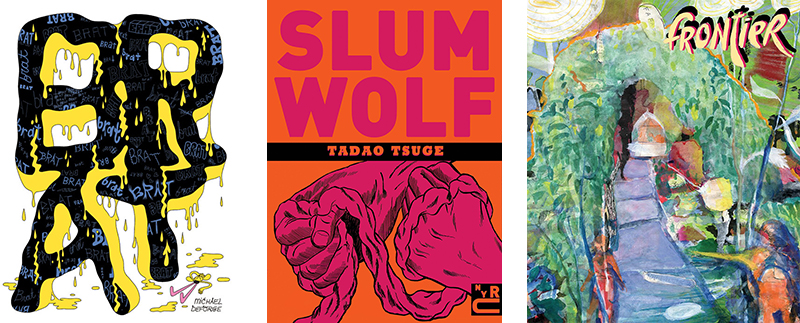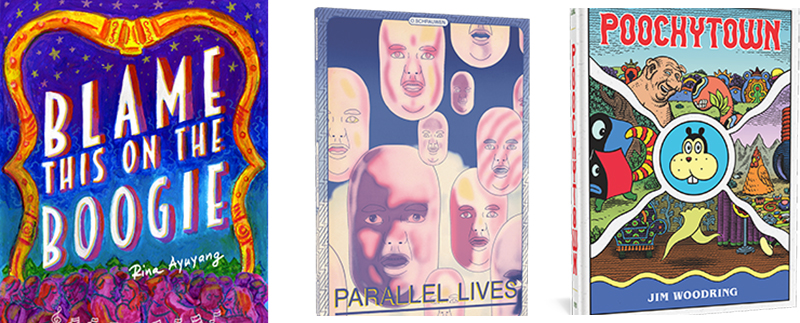Once again it’s time to look at all the “funnybooks” I read over the past 365 days and try to determine which are my most favorite of favorites. Many of the comics I wrote about for this column over the past year – Prism Stalker, Yellow Negroes, Why Art? – would easily make that short list. Not wanting to repeat myself, however, I thought instead I’d focus on some works that I didn’t have time to mention in this space. So here are 10 comics that I think are among some of the best of 2018 that I haven’t talked about here before.
Frontier #17 “Mother’s Walk” by Lauren Weinstein.
So many artists stumble when it comes to trying to portray the sheer messiness and subtle joys of life, eschewing a hard-won exultation in favor of cheap sentimentalism. Here, in the latest issue of this ongoing quarterly monograph series, Weinstein delves into the birth of her second child with humor, honesty, and grace that is nothing short of exhilarating. That she is able to do so in a mere 32 pages underscores comics’ ability to run deep in a short space. Go track this down.
Brat by Michael DeForge.
Deforge’s latest graphic novel is another tour de force — a sly, sardonic take on celebrity culture, fading youth, social media and teenage delinquency that finds the author spinning off into some truly dizzying bouts of visual invention, with each character stretching and warping into near-abstract shapes depending on their emotional state, as if they were made of silly putty. If nothing else, Brat proves that yes, DeForge is just as good as you thought he was.
Slum Wolf by Tadao Tsuge.
A collection of short stories, made during the 1960s and ’70s, of would-be tough guys, salarymen and malcontents, all wounded by poverty and love but mainly by the war, with unspoken memories of what they witnessed and did. Tsuge’s world of bottom-feeders and lost souls resonate across the continents and through the decades, ably abetted by an essay by noted translator and scholar, Ryan Holmberg, which helps put the work into context.
Poochytown by Jim Woodring.
There’s no real way to effectively summarize Woodring’s work effectively for the uninitiated in one small paragraph beyond simply saying he’s one of the most unique and brilliant cartoonists working today. Poochytown, a sequel of sorts to 2013’s Fran, finds Woodring’s main character, the chipmunked-cheeked Frank, exploring his surreal, fantasmagorical world (known as The Unifactor) with his sometimes friend/sometimes adversary Manhog and encountering all manner of bizarre, surreal — and often disturbing and horrific — creatures along the way.
Parallel Lives by Olivier Schrauwen.
Schrawuen imagines (or at least I think he imagines) being captured and prodded by aliens. Then he imagines what some of his descendents might get up to in a pastel-hued future. Then he imagines himself frozen and reanimated in an androgynous future, having to learn how to be human all over again in an androgynous future. All done in Schrauwen’s unique, off-kilter, slyly hilarious style.
Blame This on the Boogie by Rina Ayuyang.
An unabashed and utterly charming love letter to the author’s family, her childhood in Pittsburgh, movie musicals, football, and her current life in California, Ayuyang’s memoir is full to bursting with color, warmth, rhythm and straight-up joy. It’s the sort of graphic novel we need more of in these unpleasant times.
The Weaver Festival Phenomenon by Ron Rege Jr.
Rege always keeps at least one foot in the ethereal world, and it can be easy for him to get lost in the esoterica (as with his 2012 book, The Cartoon Utopia). Here, adapting a short story by Banana Yoshimoto about a young woman who is given a chance to gain closure after the death of a lover, Rege proves he is able to adhere to a more concrete story while still indulging in some truly stunning flights of fancy. This slim book takes you by surprise.
Love That Bunch by Aline Kominsky-Crumb.
Aline Crumb is one of the pioneers of autobiographical comics, producing work in the 1960s and ’70s that was shocking, fearless, and unafraid to examine the worst about herself or conform to expectations about how women were supposed to behave. A reprint of her 1990 collection (with new, added material), Love That Bunch is at turns horrifying, hilarious, insightful and always, always intense.
Art Comic by Matthew Thurber.
Having satirized Internet culture thoroughly in Infomaniacs, Thurber turns his surreal, parodic eye to the modern art industry, casting aspersions on desperate wannabees, greedy, exploitive collectors, bitter teachers and critics and much more. It’s also extremely weird and very, very funny. You don’t have to know who Matthew Barney is to appreciate this book (though it does help).
The Creepy Case Files of Margo Maloo: The Monster Mall by Drew Weing.
Finally, for the young and young at heart, here’s one of the more charming all ages series to come out in recent years. Weing imagines a modern urban city filled with hidden, quite literal monsters, few of whom conform to expected stereotypes. Maloo is the girl detective who makes it her job to protect them from the outside world, with assistance from her human assistant, Thompson. This is a straight-up smart, funny, lovingly delineated comic that captivates more with every passing page. •







